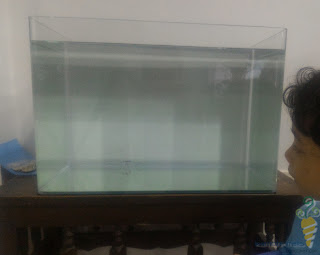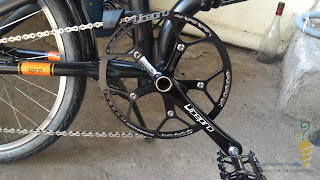Aquascaping: The Tank and the Cabinet
The tank and the stand/cabinet would be the foundation of your setup.
The tank I chose is a 15 gallon rimless tank with super clear/low iron glass. It has a curved corner that looks really good for that smooth transition. The tank came with a built in rubber matting at the bottom(not the traditional styro). The dimensions is 50cm x 30cm x 33cm. 33cm depth would give the aquascape more depth perception compared to narrow tanks. I haggled for it and got it for Php 1,300. Looking back, I should have gotten the 60cm x 30cm x 36cm tank I saw in a nearby pet store.
The cabinet is the other important part of the setup. Some use a steel frame for their aquarium stands. I prefer to use a wooden cabinet to house the equipments and supplies. My goal is to keep the equipment visibility very minimal. I would keep the filter, co2 tanks, electrical and reactors hidden inside the cabinet while exposing only the water lines in the tank. This would keep the hi tech stuff away from a natural scenery.
I made my cabinet from scrap plywoods I have in the garage. I made it slightly larger than the base of the aquarium. I got the inspiration from ADA stands and put in my own design. The inside of the cabinet will have a shelf and will house the tall co2 tank. I will mount a GFCI outlet inside to avoid any electrical disaster. The cabinet was painted black as requested by my son. Holes are cut out from the back for water lines and electrical cables. The top has a brace at the middle to help with weight distribution.
The tank fits nicely on the cabinet. I made sure to level the cabinet before putting on the tank. A tank full of water cannot be moved so any adjustments in levelling the cabinet should be made beforehand.
The doors are fitted with soft closing euro hinges. I opted for the soft close feature to prevent any vibrations or shock to the system when closing the cabinet doors.
I made a temporary light holder from scrap pieces of plywood. It will hold 2 10watt LED flood lights. This will later be replaced by a full spectrum LED aquarium light when the tank is flooded. For now, these lights will provide the light necessary for the dry start method.
The tank I chose is a 15 gallon rimless tank with super clear/low iron glass. It has a curved corner that looks really good for that smooth transition. The tank came with a built in rubber matting at the bottom(not the traditional styro). The dimensions is 50cm x 30cm x 33cm. 33cm depth would give the aquascape more depth perception compared to narrow tanks. I haggled for it and got it for Php 1,300. Looking back, I should have gotten the 60cm x 30cm x 36cm tank I saw in a nearby pet store.
The cabinet is the other important part of the setup. Some use a steel frame for their aquarium stands. I prefer to use a wooden cabinet to house the equipments and supplies. My goal is to keep the equipment visibility very minimal. I would keep the filter, co2 tanks, electrical and reactors hidden inside the cabinet while exposing only the water lines in the tank. This would keep the hi tech stuff away from a natural scenery.
I made my cabinet from scrap plywoods I have in the garage. I made it slightly larger than the base of the aquarium. I got the inspiration from ADA stands and put in my own design. The inside of the cabinet will have a shelf and will house the tall co2 tank. I will mount a GFCI outlet inside to avoid any electrical disaster. The cabinet was painted black as requested by my son. Holes are cut out from the back for water lines and electrical cables. The top has a brace at the middle to help with weight distribution.
The tank fits nicely on the cabinet. I made sure to level the cabinet before putting on the tank. A tank full of water cannot be moved so any adjustments in levelling the cabinet should be made beforehand.
The doors are fitted with soft closing euro hinges. I opted for the soft close feature to prevent any vibrations or shock to the system when closing the cabinet doors.
I made a temporary light holder from scrap pieces of plywood. It will hold 2 10watt LED flood lights. This will later be replaced by a full spectrum LED aquarium light when the tank is flooded. For now, these lights will provide the light necessary for the dry start method.









Comments
Post a Comment